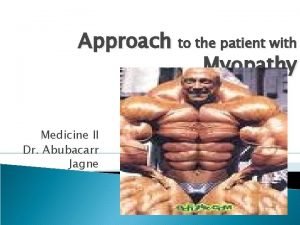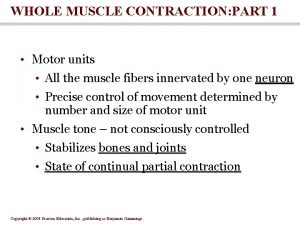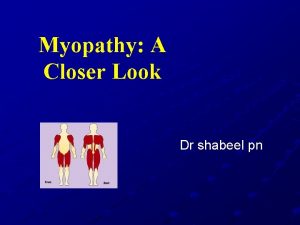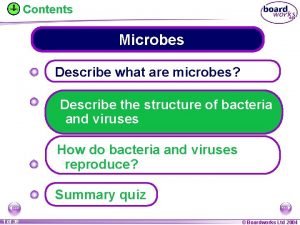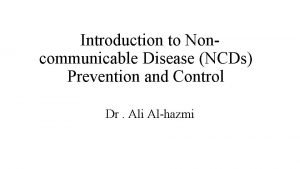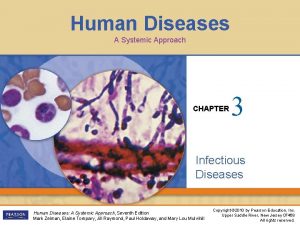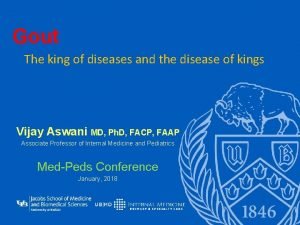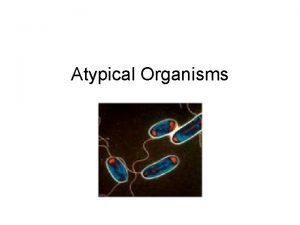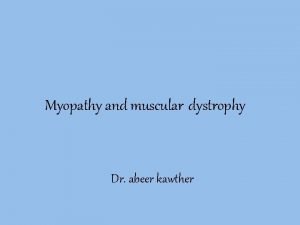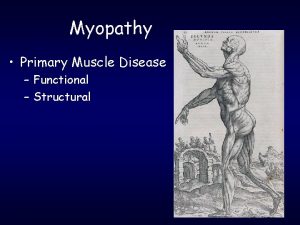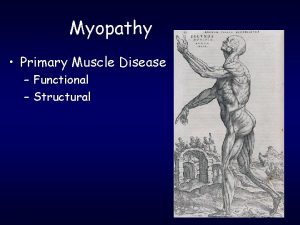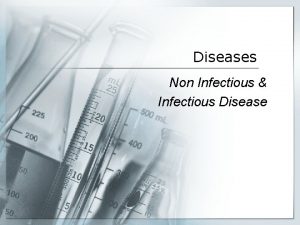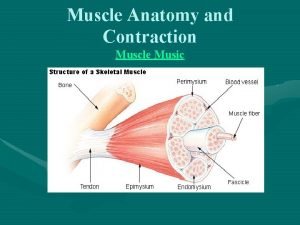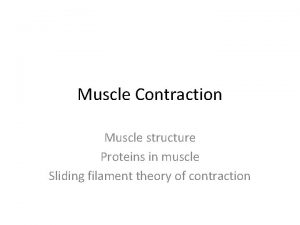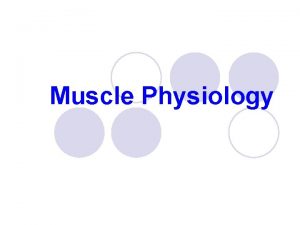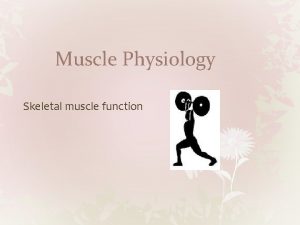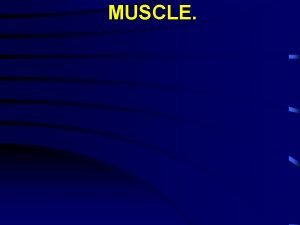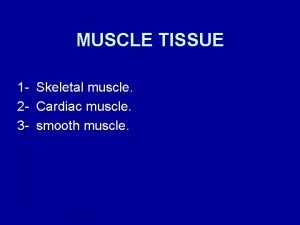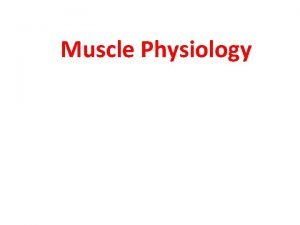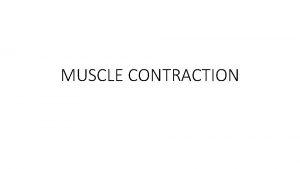DISEASES OF MUSCLE myopathy is a muscle disease




















- Slides: 20

DISEASES OF MUSCLE myopathy is a muscle disease unrelated to any disorder of innervation or neuromuscular junction. These conditions have widely varying etiologies, including congenital or inherited, idiopathic, infectious, metabolic, inflammatory, endocrine, and drug-induced or toxic.

CLINCIAL PICTURE Proximal, large muscles. Steadily progressive , s. t. episodic Symmetric Preserved tone and tendon reflexes No sensoryautonomic abnormality Cardiac failure Cardiac conduction abnormalities Respiratory problems (sleep apnea)

Outline of investigations Creatine phosphokinase (CK) EMG-NCS Muscle Biopsy (histo-biochemistry) ECG CXR Underlying cause: Ø Geneticmetabolic screen and counseling Ø Inflammatory/Endocrine/Electrolytes etc. .

Hereditary myopathies Muscular dystrophies Metabolic myopathies Mitochondrial myopathies channelopathy

Acquired myopathies inflammatory myopathies Endocrinologic Drugs and toxins

MUSCULAR DYSTROPHIES This is a group of inherited disorders characterised by progressive degeneration of groups of muscles, sometimes with involvement of the heart muscle or conducting tissue, and other parts of the nervous system Myotonic dystrophy (DM 1). Duchenne. Becker. Facioscapulohumeral (FSH). Oculopharyngeal. Emery-Dreifuss.

Clinical features v. Onset is often in childhood, although some patients, especially those with myotonic dystrophy, may present as adults. v. Wasting and weakness are usually symmetrical, v no fasciculation , v no sensory loss, v tendon reflexes are preserved until a late stage, except in myotonic dystrophy. Differential diagnosis is based on the age at onset, the distribution of affected muscles and the pattern of inheritance. Many dystrophies include cardiomyopathy

Investigations • The diagnosis can be confirmed by specific molecular genetic testing, supplemented with EMG and muscle biopsy if necessary. • Creatine kinase is markedly elevated in Duchenne muscular dystrophy, but is normal or only moderately elevated in the other dystrophies. • Screening for an associated cardiac abnormality (cardiomyopathy or dysrhythmia) is important.

Myotonic dystrophy (DM 1) Autosomal dominant. Affect any age. Face (incl. ptosis), sternomastoids, distal limb, generalised later. Myotonia, cognitive dulling, cardiac conduction abnormalities, lens opacities, frontal balding, hypogonadism.


Duchenne X-linked; deletions in dystrophin gene. First 5 years. Proximal and limb girdle. Pseudohypertrophy of calves. Cardiomyopathy.


Other variants of dystrophinopathy Becker muscular dystrophy : Is a mild form of dystrophinopathy, Patient may live many decades with mild to moderate symptoms. onset usually is after 12 years of age. Progressive weakness of girdle muscles

type Duchenne Becker Onset Before 5 years Early childhood to adult Clinical Features Progressive weakness of girdle muscles Unable to walk after age 12 Progressive weakness of girdle muscles Able to walk after age 15 Mental impairment uncommon Common

Facioscapulohumeral (FSH) Autosomal dominant. 7 -30 years. Face and upper limb girdle. Winging of scapula.

Emery-Dreifuss 4 -5 years Humero- peronal, proximal limb girdle later Contractures develop early. Cardiac involvement leads to sudden death

CHANNELOPATHIES Inherited abnormalities of the sodium, calcium and chloride ion channels in striated muscle produce various syndromes of familial periodic paralysis, Myotonia and malignant hyperthermia

Hypokalaemic periodic paralysis Ø a muscle calcium or sodium channel disorder Ø autosomal dominant • Attacks are precipitated by a period of exercise followed by rest or by carbohydrate loading. Attacks typically develop in the early hours of the morning and may last hours to days. • Serum potassium is typically low at the onset but may normalize quickly. • patients with hypokalaemic paralysis will notice improvement with potassium ingestion but worsening with glucose. • Thyroid disorder mainly hyperthyroidism can associated with the disease.

Hyperkalaemic periodic paralysis sodium channel In hyperkalaemic periodic paralysis (hyper. PP) patients typically experience recurrent attacks of muscle weakness • Precipitants include rest following exercise, cold, potassium ingestion or stress. • Attacks may vary in severity from mild weakness to total paralysis, The duration of attacks is usually less than 2 hours. • Many attacks are brief and do not require treatment. • If necessary, acute attacks can be terminated by ingestion of carbohydrate or inhaled salbutamol. • Preventative treatment with acetazolamide or a thiazide diuretic may be required.

Drug induced myopathy • Corticosteroids • Chloroquine • Amiodarone • β-blockers • Statins • Vincristine • Zidovudine • Opiates
 Myopathy
Myopathy Site:slidetodoc.com
Site:slidetodoc.com Steroid myopathy
Steroid myopathy Communicable disease and non communicable disease
Communicable disease and non communicable disease Smooth muscle cell
Smooth muscle cell _____ muscles run across the cheek.
_____ muscles run across the cheek. Is hemophilia communicable or noncommunicable
Is hemophilia communicable or noncommunicable Microbes
Microbes Nursing management of reproductive tract infection
Nursing management of reproductive tract infection Chapter 23 lesson 1 understanding communicable diseases
Chapter 23 lesson 1 understanding communicable diseases Sexually transmitted diseases
Sexually transmitted diseases Myths and fallacies about non communicable diseases
Myths and fallacies about non communicable diseases Diseases spread by pathogens
Diseases spread by pathogens Human diseases a systemic approach
Human diseases a systemic approach King of diseases
King of diseases Albugo eye
Albugo eye Chapter 17 reproductive system diseases and disorders
Chapter 17 reproductive system diseases and disorders Gurus of total quality management
Gurus of total quality management Non communicable diseases infographic
Non communicable diseases infographic Define a primary skin lesion and list three types
Define a primary skin lesion and list three types Giemsa stain
Giemsa stain
